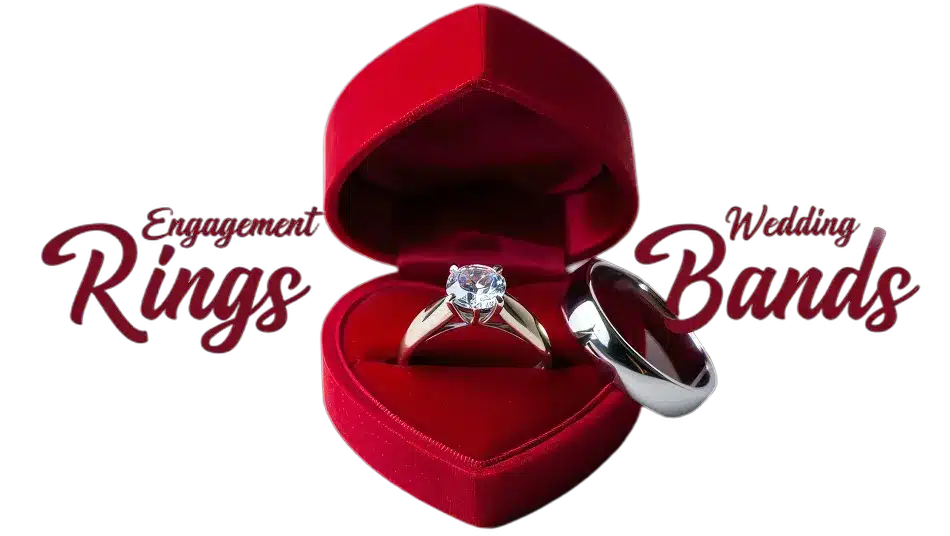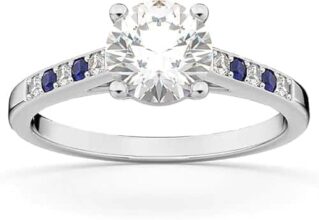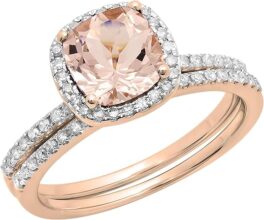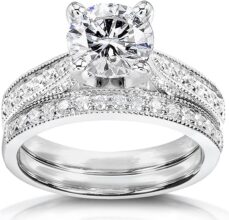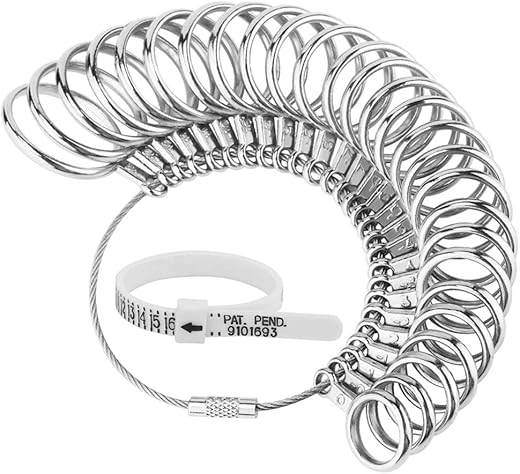
Why Ring Sizing Matters
Did you know that nearly 30% of engagement rings need resizing? That’s a staggering number, especially when you consider the emotional significance of this special piece. Choosing the right size for your engagement ring is not just about aesthetics; it’s about comfort and everyday wearability. Imagine wearing a ring that constantly slips off or feels unbearably tight—hardly the experience you want when celebrating a lifelong commitment!
Getting the right fit enhances not only the beauty of the ring but also how it feels on your finger. An ill-fitting ring can detract from the joy of wearing it, causing unnecessary anxiety. So, whether you’re a first-time buyer or just looking to refresh your knowledge, understanding ring sizing is essential.
Get ready to dive into the world of ring sizing and discover best practices that will help you say “yes” to the perfect fit for your forever ring!




Understanding Ring Sizes
When it comes to engagement rings, understanding ring sizes isn’t just a technical detail—it’s a key part of ensuring you have a ring that fits both physically and emotionally. Ring sizes are typically referred to in a numerical system, but there are multiple sizing systems used around the world, including the US, UK, and European sizing methods. Familiarizing yourself with these systems is your first step in securing that perfect ring.
The Basics of Ring Sizes
In the United States, ring sizes range from 3 to 13, with half and quarter sizes available for a more tailored fit. A size 7 ring, for instance, has an inner circumference of about 54.4 mm or 2.14 inches. Meanwhile, the UK uses an alphabetic system—size F corresponds to the US size 3, and size Z corresponds to US size 13. In Europe, sizes are typically measured in millimeters and thus can look quite different, but once you know your size in one system, converting to another becomes simpler.
Knowing your exact ring size is essential for various reasons. Firstly, when selecting a ring, you’ll want it to fit comfortably without sliding off or feeling pinched. Secondly, precise sizing becomes even more critical if you’re considering rings with wider bands, which often require a larger size than traditional, more narrow bands.
Why Sizing Is Important
Imagine the joy of proposing with the perfect ring, only for it to be too tight to wear! An ill-fitting ring can lead not only to discomfort but also to the risk of losing the ring altogether. This is particularly important for significant moments like engagements, where every detail counts.
Ring Sizing Tools: Take the Guesswork Out
One tool that can be incredibly helpful in determining your size at home is the Mudder Stainless Steel Ring Gauge Set. This handy device allows you to easily measure your ring size without the need for professional assistance, providing a clear and accurate result.
An accurate ring size reduces the chance of disappointment when your chosen piece arrives. It enhances the joy of wearing your ring every day, making it a constant reminder of a cherished moment.
Understanding ring sizes is not just about numbers; it’s about ensuring that the ring you choose is a true reflection of your love and commitment. Now that you’ve grasped the basics, let’s move on to the next step: how to measure your ring size at home effectively.
How to Measure Your Ring Size at Home
Measuring your ring size at home can be a simple and satisfying process. You don’t need to visit a jeweler to get an accurate measurement; with just a few household items, you can find a size that feels right. Here’s how to do it!
Method 1: Using a Ring Sizer
One of the easiest ways to get a precise measurement is to use a ring sizer, which can often be purchased online or at your local jewelry store. These come in various designs, often resembling a set of rings in graduated sizes. Simply slide the rings over the finger you intend to wear the engagement ring on until you find the perfect fit.
This tool is particularly useful for trying on different sizes without leaving your home, saving time and hassle.
Method 2: The String or Paper Method
If you don’t have a ring sizer, fear not! You can use a piece of string or a strip of paper to measure your size. Here’s how:
- Cut a Length: Take a piece of string or paper about 6 inches long.
- Wrap It: Wrap it around the base of the finger you plan to wear the ring on. Ensure it sits snugly but not too tightly.
- Mark the Spot: Use a pen to mark the point where the two ends meet.
- Measure the Length: Lay the string or paper flat and use a ruler to measure the length you marked (in millimeters).
Method 3: Measuring an Existing Ring
If you have a ring that fits well, you can easily measure the inner diameter:
- Select the Right Ring: Choose a ring that you wear comfortably on the same finger.
- Use a Ruler: Measure the inner diameter of the ring (the width across the inside of the band) in millimeters.
- Find the Size: Compare your measurement to a ring size chart to find your size.
Final Tips to Consider
With these methods, you should be well on your way to determining your perfect ring size. The next step is to consider the common mistakes that can occur during this process to ensure your measurements are as precise as possible!
Common Mistakes to Avoid When Sizing Rings
As you embark on the quest for the perfect engagement ring, it’s essential to sidestep some common pitfalls that could lead to an ill-fitting ring. Trust us, the last thing you want is to experience the disappointment of a ring that’s too loose or too tight. Here are crucial mistakes to steer clear of while you measure your ring size.
Timing is Everything
One of the most significant errors you can make when sizing a ring is measuring at the wrong time of day. Your fingers are not the same size throughout the day; they can swell due to heat, physical activity, or even just the time of year. For best results, aim to take your measurements in the evening when your fingers are likely to be at their largest.
Forgetting the Knuckle
Ignoring the size of your knuckle is another common oversight. If your knuckle is notably larger than the base of your finger, it may cause a beautiful ring to get stuck or feel uncomfortably snug. When measuring, ensure that the ring can slide comfortably over your knuckle while still feeling secure at the base of your finger. A quick tip: if you’ve measured your finger and find that it’s at the higher end of your size range, consider adjusting your size up a bit to accommodate the knuckle.
Rushing the Process
It’s easy to feel rushed during the excitement of choosing an engagement ring, but taking the time to measure correctly is crucial. Hasty measurements can lead to inaccuracies that may result in extra trips to the jeweler for resizing. Be patient, and consider measuring multiple times, perhaps even over a span of a day or two, to ensure you get a consistent result.
Ignoring Band Width
Another mistake many make is failing to account for the width of the band. Wider rings tend to fit tighter than narrower bands, so if you’re eyeing a chunky design, you may need to go up half a size. Keep this in mind when you’re evaluating what size to choose.
These handy little tools can help customize the fit of a too-large ring temporarily, providing a quick fix while you finalize the size to order.
Not Utilizing Available Resources
Lastly, many people overlook the vast resources available online and within jewelry stores. Ring sizers, printable templates, and conversion charts can be invaluable. Utilize these tools to gain a more accurate measurement, and always check with your jeweler for guidance—they’re professionals who want to help you find that perfect fit!
By avoiding these common mistakes, you set yourself up for success in securing a ring that’s not only stunning but also comfortable to wear every day. Now that you’ve equipped yourself with knowledge on what to avoid, let’s delve into the next important topic: adjusting ring sizes and what you can expect when you need a resize.
Adjusting Ring Sizes: What to Expect
When you finally find the engagement ring of your dreams, but it doesn’t quite fit, don’t worry! Ring resizing is a common process, and with the right information, you’ll know exactly what to expect.
The Resizing Process
Resizing typically involves adding or removing material from the band, depending on whether you need the ring to fit tighter or looser. Most jewelers can resize rings within 1 to 2 sizes either way. Here’s how it generally works:
- Consultation: Start by visiting a jeweler, where they’ll assess the ring and discuss your preferences.
- Resizing: The jeweler will either stretch the band for larger sizes or cut and solder metal for smaller sizes.
- Finishing Touches: After resizing, the ring will be polished to restore its shine and finish.
Timing
When it comes to how long you’ll have to wait, resizing generally takes about 1 to 2 weeks, although this can vary based on the jeweler’s workload and the complexity of the ring. If you’re under a time crunch—like an impending wedding or anniversary—make sure to communicate this upfront. Some jewelers offer expedited services for an added fee.
Cost
The cost for resizing varies, typically ranging from $20 to $100. Factors that can influence the price include:
When to Resize vs. Buy New
While resizing is a feasible solution, there are occasions when opting for a new ring might be more prudent. Consider the following:
Conditions for Resizing
Be mindful of conditions that affect resizing:
As you now know, whether you choose to resize or buy a new ring, understanding the process can help you make a confident decision. Armed with this knowledge, let’s explore how to choose the right ring style based on your size—because finding the perfect fit goes beyond just numbers!
Tips for Choosing the Right Ring Style Based on Size
Now that you have a solid grasp on how to measure your ring size accurately and the potential need for resizing, it’s time to consider how your size influences the style of the engagement ring you choose. Ring size can play a significant role in the design, setting, and even the gemstone. Here are some tips to help you navigate these choices effectively.
Consider the Band Width
One of the first decisions you’ll face is the width of the band. Wider bands can create a statement and may require a size adjustment since they often fit more snugly. If you have smaller fingers, a narrow band can elongate the look of your hand, making it appear more delicate. Conversely, if you have larger hands, a wider band can provide the balance and presence to complement your finger size. Here are some thoughts to consider:
Gemstone Size Matters
When it comes to stones, size and scale matter. A massive center stone can overwhelm petite fingers, while smaller stones might get lost on larger hands. Aim for a proportionate balance:
Settings That Elevate Style
The setting you choose also impacts the overall look of the ring. Here are a few types of settings to consider based on your size:
Height and Profile
Consider the ring’s profile or height above the finger. A high-profile setting can make a ring look larger and more prominent. If your fingers are short or small, a lower-profile setting can create a streamlined look, allowing the ring to contour gracefully along the finger.
This versatile option accommodates various styles and sizes, giving you the freedom to adapt it to your preference!
Final Thoughts
Choosing an engagement ring style based on size isn’t merely about numbers; it’s about creating a beautiful piece that resonates with personal aesthetics while complementing your hand’s natural features. With these tips in mind, you’re equipped to explore styles that not only fit your fingers but also your unique taste. Now that you’ve got the inside scoop on selecting the perfect ring style for your size, let’s transition into our conclusion—where the perfect fit truly awaits.
The Perfect Fit Awaits
As you wrap up your journey to finding the perfect engagement ring, remember that sizing truly matters. A well-fitted ring is more than just a piece of jewelry; it’s a symbol of your love and commitment. By understanding the nuances of ring sizes and following the simple steps we’ve discussed, you’ll ensure that your chosen ring fits beautifully, representing a perfect match for your unique relationship.
So, whether you’re crafting a surprise or choosing together, take the time to measure carefully and consider all options. Your commitment deserves nothing less than the perfect fit—because every love story is special, and the ring should reflect exactly that. Happy ring hunting!
